
26-29 июля 2011 г., Горный Алтай
В конце июля 2011 года на базе ОАО “РЖД”, расположенной в Горном Алтае, состоялось очередное II рабочее совещание российских производителей катализаторов “Катализ в промышленности. Задачи. Пути решения”. Инициатором проведения ежегодного мероприятия является Институт катализа СО РАН, организаторами совещания в этом году выступили ООО “НПК “Синтез” (г. Барнаул) и Администрация Алтайского края при активной поддержке и участии представителей Минпромторга России. В работе совещания приняли участие представители ведущих российских производителей катализаторов, в том числе ОАО “Ангарский завод катализаторов и органического синтеза”, ООО “Салаватский катализаторный завод”, ЗАО “Промышленные катализаторы” (г. Рязань), ООО “Экоальянс” (бывший Завод автомобильных катализаторов ФГУП “УЭХК”), ОАО “Синтез-Каучук” (“Стерлитамакский завод СК”), ОАО “Катализатор”, ОАО “НИАП-КАТАЛИЗАТОР”, ООО “Новомичуринский катализаторный завод”, а также поставщиков сырья и материалов для катализаторных производств – Sasol Germany GmbH (Германия), ОАО “Русал”, ОАО “Красцветмет”, Новосибирский завод редких металлов, НПФ “Балтийская мануфактура”.
Цель рабочего совещания – обсуждение текущего состояния и перспектив развития катализаторной промышленности России.
В рамках совещания обсуждались следующие проблемы:
С ключевыми докладами выступили директор Института катализа СО РАН академик В.Н. Пармон, директор Института проблем переработки углеводородов СО РАН (г. Омск) член-корр. РАН В.А. Лихолобов, генеральный директор ОАО “ВНИПИнефть” (г. Москва) д.т.н. В.М. Капустин.
В докладе академика В.Н. Пармона освещались вопросы создания и функционирования технологической платформы “Глубокая переработка углеводородного сырья” – нового инструмента объединения усилий государства, бизнеса и науки в определении инновационных приоритетов в данной сфере, разработке программы стратегических исследований и определении путей ее реализации.
Директором Института проблем переработки углеводородов СО РАН В.А. Лихолобовым были представлены перспективные разработки катализаторов процессов нефтепереработки и нефтехимии, в частности катализаторы, предназначенные для систем риформинга как со стационарным слоем и периодической регенерацией катализатора, так и с движущимся слоем и непрерывной регенерацией катализатора. По своим характеристикам новые катализаторы не уступают зарубежным аналогам и способны обеспечить импортозамещение на отечественных НПЗ.
В выступлении генерального директора ОАО “ВНИПИнефть” В.М. Капустина была высказана озабоченность развитием российской нефтепереработки в целом и катализаторной подотрасли в частности. Так, было отмечено, что состояние этих производств характеризуется усилением ряда негативных тенденций:
Результатом совокупного действия отмеченных тенденций является постепенное вытеснение отечественных производителей катализаторов с российского рынка катализаторов.
Вместе с тем наличие российских разработок мирового уровня и усилия отдельных катализаторных предприятий в области модернизации своего производства и обновления номенклатуры своей продукции создают возможности для отечественной катализаторной подотрасли не только выбраться из многолетнего кризиса, но и претендовать на лидирующие позиции на мировом рынке. И такие примеры уже есть, о чем свидетельствуют выступления генерального директора ООО “Экоальянс” Н.М. Данченко, первого заместителя генерального директора ОАО “Росхимзащита” С.Б. Путина, генерального директора ООО НПК “Синтез” О.А. Парахина.
По результатам обсуждений участниками совещания единодушно была принята итоговая резолюция, включающая следующие пункты:
По предложению представителей ООО “Салаватский катализаторный завод” местом проведения следующего совещания летом 2012 г. выбрана Республика Башкортостан.
Акад. В.Н. Пармон
Д.т.н. А.С. Носков
 |
VI Научно–практическая конференция с международным участием "Сверхкритические флюиды (СКФ): фундаментальные основы, технологии, инновации" 4 -7 июля, 20011 г. пос. Листвянка, Иркутская обл. |
C 4 по 7 июля 2011 г. в Байкальском музее Ир НЦ СОРАН в пос. Листвянка Иркутской обл. состоялась VI Научно-практическая конференция с международным участием "Сверхкритические флюиды: фундаментальные основы, технологии, инновации", организованная Учреждением Российской академии наук Институтом катализа им. Г.К. Борескова Сибирского отделения РАН, Учреждением Российской академии наук Институтом общей и неорганической химии им. Н.С. Курнакова РАН, Химическим факультетом Московского государственного университета имени М.В. Ломоносова, Байкальским музеем ИНЦ СО РАН, Редакционной коллегией журнала "Сверхкритические флюиды: теория и практика" и ЗАО "ШАГ". Финансовую поддержку конференции оказали Российский фонд фундаментальных исследований и компании: ЗАО "ШАГ", Waters Ges. m.b.H., ООО "Промэнерголаб" и ООО "Ростбиохим".
Конференция продолжила начатый в 2004 году в г. Ростове цикл конференций по важному и перспективному направлению технологического развития общества, обеспечивающего экологическую чистоту и безопасность производственных процессов в полном соответствии с принципами и стандартами "Зеленой химии". Эффект от внедрения СКФ-технологий уже в ближайшие годы может быть сопоставимым с эффектом от внедрения лазерных и информационных технологий. Как показали предыдущие конференции, для этого необходима интеграция российских научно-исследовательских организаций, университетов, высокотехнологичных предприятий, государственных органов власти и инвесторов, которая позволила бы в кратчайшие сроки достичь мирового уровня развития технологии и внедрения ее в практику. Была отмечена высокая заинтересованность инновационным потенциалом СКФ-технологий в научных, промышленных и административных кругах России и значимость развития сверхкритических флюидных технологий для экономического роста и национальной безопасности России. Существующие в России научные школы в области СКФ работают на мировом уровне и вполне способны обеспечить научную поддержку развития СКФ-технологий в России.
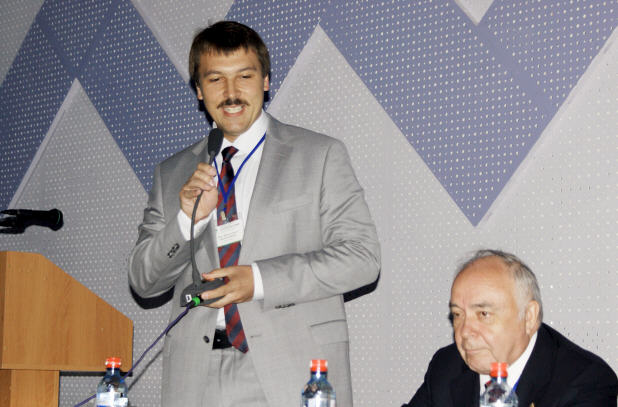
Д.х.н. О.Н. Мартьянов (Институт катализа СО РАН),
академик В.В. Лунин (Химический факультет МГУ)
Особенностью настоящей конференции стало то, что она была первой конференцией этого цикла, проводимой в Сибири (пять предыдущих конференций проводились в Европейской части России). Это позволяет надеяться на привлечение к решению проблем СКФ богатого научного, технологического потенциала и ресурсов восточных регионов России.
Основные направления работы Конференции:
В рамках СКФ-конференции прошли конференции-сателлиты: II Всероссийская школа-конференция молодых учёных "Сверхкритические флюидные технологии в решении экологических проблем" и Всероссийский симпозиум "Сверхкритические флюидные технологии для фармацевтики, биомедицинского материаловедения и биотехнологии" (с международным участием).
В работе конференции приняли участие 136 участников из 8 стран мира (Россия, Украина, Франция, Великобритания, США), представляющие 27 городов. Почти треть участников – это молодые ученые, работающие как в институтах Академии наук РФ, ВУЗах, так и в коммерческих организациях. Наиболее крупные делегации прибыли из Москвы, Казани, Новосибирска, Архангельска, Троицка, Иваново; наиболее представительные – из Института химии растворов РАН (Иваново), Казанского государственного технологического университета, Института проблем лазерных и информационных технологий РАН (Троицк) и ЗАО "ШАГ".
В работе конференции участвовали 38 докторов наук и 39 кандидатов наук по различным специальностям.
Вниманию участников было представлено 5 пленарных докладов, 4 ключевых приглашенных выступления, 37 устных докладов, включая презентационные доклады ведущих компании, 17 устных докладов молодых участников и 45 стендов.
Председатель оргкомитета Конференции академик В.В. Лунин открыл Конференцию вступительной речью, в которой были отмечены основные вехи развития СКФ и СКФТ в Российской Федерации. С приветственными словами к участникам обратились к.г.н. В.А. Фиалков, директор Байкальского музея ИНЦ СО РАН, и д.х.н. О.Н. Мартьянов, зам. директора Института катализа Сибирского отделения РАН.
Научная программа конференции открылась обзорной лекцией "РАЗВИТИЕ НАУЧНО-ОБРАЗОВАТЕЛЬНОГО ЦЕНТРА ПО СВЕРХКРИТИЧЕСКИМ ФЛЮИДАМ ХИМИЧЕСКОГО ФАКУЛЬТЕТА МГУ", представленной от имени коллектива соавторов – участников НОЦ – ученым секретарем НОЦ СКФ, д.х.н. С.З. Вацадзе (Химический факультет МГУ имени М.В. Ломоносова, Москва). В докладе были рассмотрены основные направления научно-исследовательской деятельности НОЦ СКФ, которые включают реакции создания связей С-С, в том числе каталитические; получение и модификацию гелей и металлогелей, в том числе ксерогелей и аэрогелей; получение и модификацию координационных полимеров; получение и модификацию катализаторов; проведение реакций полимеризации и поликонденсации. Было отмечено, что НОЦ СКФ является инициатором и базой для создания Федерального научно-образовательного центра по сверхкритическим флюидам.
В пленарной лекции "POLYMER SYNTHESIS, POLYMER PROCESSING AND MEDICAL DEVICES: A SUPERCRITICAL AP-PROACH" профессор Steven M. Howdle (School of Chemistry, University of Nottingham, UK) ярко доложил о новейших достижениях в области дисперсионной полимеризации в среде ск-СО2. Путем выбора так называемых "СО2-фильных групп" удается создать растворимые в ск-СО2 мономеры, что позволяет вести контролируемую дисперсионную полимеризацию для получения АВ-диблоксополимеров. Другим подходом является модификация физических свойств полимеров, возможная при воздействии ск-СО2. В частности, удается связывать в полимерную матрицу некоторые гормоны и лекарства. Полученные в результате материалы представляют высокую ценность в области инженерии тканей и доставки лекарственных средств.
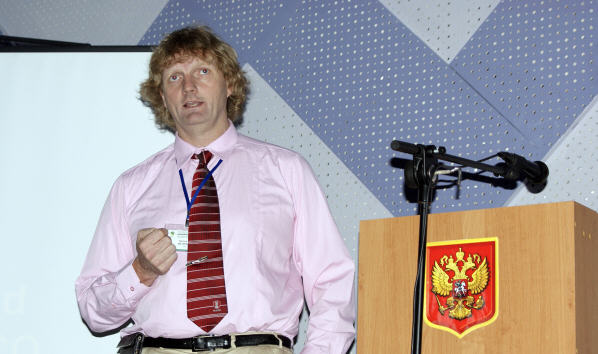
Prof. Steven M. Howdle (School of Chemistry, University of Nottingham, UK)
В пленарной лекции д.х.н. О.Н. Мартьянова (Институт катализа им. Г.К. Борескова Сибирского отделения РАН, Новосибирск) "ФИЗИКО-ХИМИЧЕСКИЕ АСПЕКТЫ ПРИМЕНЕНИЯ СВЕРХКРИТИЧЕСКИХ ФЛЮИДОВ В ГЕТЕРОГЕННОМ КАТАЛИЗЕ" был представлен анализ современного состояния фундаментальных и технологических исследований, направленных на решение проблем в области использования сверхкритических флюидов в гетерогенном катализе. Докладчик убедительно показал, что понимание механизмов протекания гетерогенных каталитических реакций в сверхкритических условиях, которое имело бы предсказательную силу, находится на недостаточном уровне развития. Целью представленного доклада были анализ и иллюстрация на примере известных экспериментальных данных влияния основных физико-химических особенностей сверхкритических флюидов на гетерогенные каталитические процессы. В частности, были продемонстрированы блестящие возможности спектроскопии ЭПР для изучения поведения воды в суб- и сверхкритических условиях.
В познавательной пленарной лекции "SOFT PROCESSING FOR SUSTAINABLE SOCIETY: POSSIBILITY OF WATER-BASED PROCESSING FOR ADVANCED INORGANIC MATERIALS" профессора Masahiro Yoshimura (Tokyo Institute of Technology, Japan and National Cheng Kung University, Taiwan) была отмечена важность развития и применения энергосберегающих технологий. В особенности это касается синтеза новых материалов с заданными свойствами в мягких условиях, к которым относятся многие процессы СКФТ. На примере синтеза неорганических пленок убедительно показаны преимущества новых технологий, которые автором названы как "soft processing". В частности, новые подходы оказались крайне удобными при получении неорганических наночастиц заданного размера и формы.
В пленарной лекции "LIQUID WATER: A STATE BETWEEN TWO CRITICAL POINTS" профессор М.А. Анисимов (University of Maryland, College Park, MD 20742, Maryland, USA) выдвинул оригинальную гипотезу о том, что жидкая вода в температурных экстремумах своего существования – около критической точки и в переохлажденном состоянии – представляет собой два разных вещества. Особый интерес вызывают свойства воды при низких температурах, которые можно объяснить существованием второй критической точки в метастабильном переохлажденном состоянии.
Заключительная пленарная лекция д.х.н., профессора С.П. Губина (Институт общей и неорганической химии им. Н.С. Курнакова РАН, Москва) "СК ИЗОПРОПАНОЛ: ОТ ПЕРЕРАБОТКИ СЫРЬЯ ДО НАНОТЕХНОЛОГИЙ" вызвала огромный интерес слушателей. В докладе рассмотрено использование уникальной системы СК-изопропанол – СК-ацетон в качестве аккумулятора и переносчика водорода. Известные технологические преимущества сверхкритических флюидов в сочетании с высокой восстанавливающей активностью СК-изопропанола открывают возможности создания инновационных технологий переработки бурых углей и лигнина и очистки тяжёлых нефтяных фракций. Большой экспериментальный материал по избирательному восстановлению неорганических соединений (оксидов, сульфидов и т.п.) убедительно свидетельствует о том, что это может стать основой новых технологий переработки минерального сырья и промпродуктов. При решении проблем нанотехнологий возможности системы СК-изопропанол – СК-ацетон проявились не менее ярко. Как пример - создание наноматериалов с заданными свойствами при химических превращениях наночастиц внутри матриц различного состава под действием СК-изопропанола.
Ключевую сессию открыл доклад В.К. Попова (Институт проблем лазерных и информационных технологий РАН, Троицк) "Сверхкритические флюидные технологии для фармацевтики и тканевой инженерии". В докладе представлены результаты исследований процессов сверхкритической флюидной (СКФ) микронизации биоактивных субстанций и их инкапсуляции в биорезорбируемые полимерные матрицы, базирующиеся на явлениях пластификации, набухания или вспенивания алифатических полиэфиров при их взаимодействии со сверхкритическим диоксидом углерода. На примере лекарственных средств различных фармакотерапевтических групп (растительных экстрактов и иммунотоксинов, синтетических ранозаживляющих пептидов, нестероидных противовоспалительных и антипсихотических лекарственных средств) продемонстрирована принципиальная возможность создания высокоэффективных, низкотоксичных и относительно недорогих препаратов пролонгированного действия для лечения социально значимых заболеваний с помощью экологически безопасных СКФ технологий.
Тема использования новых материалов в медицине была далее детально развита в ключевой лекции профессора В.И. Севастьянова (ФГУ "Федеральный научный центр трансплантологии и искусственных органов им. В.И. Шумакова" Минздравсоцразвития России, Москва) "Биополимерные материалы в тканеинженерных конструкциях и биоискусcтвенных органах". В докладе были представлены основные направления исследований в области тканевой инженерии, перечислены тканеинженерные продукты для регенерации кожи, хрящевой, костной и других тканей, находящиеся на различных этапах разработки, а также технологические решения, необходимые для практического применения методов тканеинженерных конструкций и биоискусственных органов. Отмечено, что СКФТ являются наиболее перспективными технологиями в плане создания новых имплантатов, поэтому требуется развивать более тесные связи между специалистами в области СКФ и представителями отечественной медицины.
Синтетические аспекты применения СКФ как растворителей были рассмотрены в ключевой лекции к.х.н. А.М. Чибиряева (Новосибирский государственный университет, Новосибирский институт органической химии СО РАН, Новосибирск) "Перспективы использования оксидов металлов в СКФ: каталитические превращения и другие реакции". Автором показано, что исходя из опыта использования оксидов металлов (ОМ) в СКФ, можно выделить, по меньшей мере, три типа их поведения: 1) ОМ как реальный катализатор превращения; 2) ОМ как основа, матрица для нанесения (фиксации) истинного катализатора; 3) ОМ как один из реагентов изучаемой химической реакции. Знание химических свойств самих оксидов металлов и тех СК сред, в которых планируется их использовать, является основой для успешного внедрения ОМ в практику СКФ-технологий. В докладе были рассмотрены примеры реакций, демонстрирующие указанные три типа поведения ОМ в СКФ.
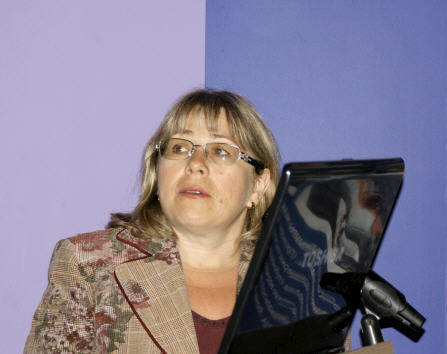
Д.х.н. Е.С. Локтева, Химический факультет МГУ
Ключевая лекция "Гетерогенный катализ в сверхкритических условиях: теория и практика" д.х.н. В.И. Богдана (Институт органической химии им. Н.Д. Зелинского РАН, Москва) была также посвящена каталитическим превращениям. Однако, в отличие от предыдущего доклада, здесь автором рассматривались процессы превращения алканов на гетерогенных цеолитных катализаторах. Проведение реакций при температуре и давлении выше критических значений позволяет использовать такие уникальные свойства сверхкритических флюидов, как их высокая по сравнению с газами плотность, растворяющая способность, теплопроводность, высокая по сравнению с жидкостями скорость диффузии и сжимаемость в широких пределах. При использовании этих свойств открывается несколько возможностей для улучшения кинетических характеристик гетерогенно-каталитических реакций: (1) неограниченная смешиваемость реагентов, трудно растворимых друг в друге в обычных условиях, способствующая увеличению активности катализаторов, изменению селективности процессов; (2) in situ экстракция и удаление с поверхности катализатора образующихся в результате побочных реакций конденсированных непредельных соединений, приводящие к увеличению времени жизни катализатора и его производительности.
На секции устных докладов сообщение С.А. Синицына (Москва) было посвящено получению армированных биополимеров медицинского назначения. В лекции А.Б. Соловьевой (Москва) рассказано об особенностях фотохимического поведения фотохромных спиросоединений, импрегнированных в полимерных матрицах с помощью ск-СО2. И.В. Шишковский (Самара) сообщил о возможностях селективного лазерного спекания пористых фильтров с нанокаталитическими вставками. В докладе А.В. Шишкина (Новосибирск) сообщалось о синтезе наночастиц и органических веществ при окислении Zr и W СКФ Н2О/СО2. Сообщение В.А. Авраменко (Владивосток) было посвящено проблемам гидротермального и СК окисления металл-органических комплексов. Как всегда, большой интерес вызвало выступление Ф.М. Гумерова (Казань), в котором автор рассказал о решении проблем получения биодизеля на основе реакции трансэтерификации в СКФ условиях. В.Г. Матвеева (Тверь) сделала сообщение о современной ситуации в области СКФТ окисления и восстановления. С большим интересом слушатели встретили доклад Е.С. Локтевой (Москва), посвященный вопросам регенерации нанесенных палладиевых катализаторов восстановительного гидродехлорирования хлорорганических экотоксикантов. В выступлении О.Н. Федяевой (Новосибирск) затрагивались вопросы механизмов термохимических превращений органического вещества углей в СК воде. Доклад Э.Е. Саид-Галиева (Москва) был посвящен синтезу, структурным и каталитическим исследованиям моно- и биметаллических катализаторов, полученных с помощью СКФТ. В лекции А.А. Вострикова (Новосибирск) рассматривались вопросы конверсии битумов в СК воде. Интересное сообщение Е.М. Глебова (Новосибирск) было посвящено изучению реакции диенового синтеза в среде ск-СО2. Поведение и фазовые превращения водно-углеводородных флюидов при повышенных температурах и давлениях были темой сообщения М.А. Новиковой (Черноголовка). С интересом была встречена лекция В.М. Валяшко (Москва) о критических явлениях в бинарных и тройных системах, образованных компонентами разной летучести. В докладе A. Idrissi (Франция) рассказывалось о возможностях расчетов смесей ацетон/СО2 и этанол/СО2. В лекции Б.И. Седунова (Москва) сделана попытка анализа теплофизических свойств СКФ новым методом. Р.Д. Опарин (Иваново) рассказал о влиянии температуры и давления на растворимость ацетаминофена в ск-СО2. Извлечению органических примесей из различных матриц методом СФЭ посвящена лекция И.А. Ревельского (Москва). Сообщение о моделировании процесса экстрагирования этиленоксида из водного раствора с помощью ск-СО2 было сделано Д.Д. Ахметлатыйповой (Казань). Вопросы комплексной переработки угля с применением метода СФЭ затрагивались в докладе С.Х. Лифшиц (Якутск). Интересное сообщение о возможности создания опытной установки СКВО производительностью 200 кг/час сделали А.Е. Розен и А.Е. Зверовщиков (Пенза).
5-го и 6-го июля были проведены две стендовые сессии, на которых представили свои разработки 45 докладчиков. Среди стендовых докладов особо были отмечены доклады молодых участников А.Г. Худошина, И.В. Кучурова, О.И. Покровского, Н.В. Минаева, Д.А. Чепелянского, И.В. Кузнецовой, В.Ф. Хайрутдинова, С.В. Балахонова.
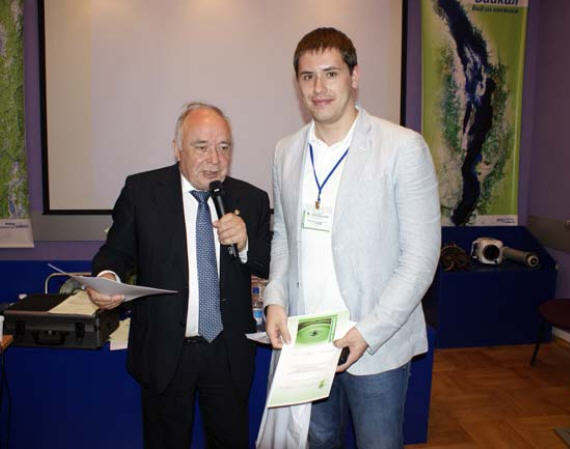
Награждение И.В. Кучурова
(Институт органической химии им. Н.Д. Зелинского, г. Москва)
На закрытии Конференции были награждены Почетными грамотами оргкомитета за наиболее интересные исследования молодые ученые С.А. Сошин (УНИВЕРСАЛЬНАЯ ПЛАТФОРМА ДЛЯ ПОСТРОЕНИЯ СИСТЕМ, ИСПОЛЬЗУЮЩИХ ГАЗЫ В СВЕРХКРИТИЧЕСКОМ СОСТОЯНИИ,ООО "НПО-СВ-Хроматография",г. Нижний Тагил), И.В. Кучуров (ПОЛУЧЕНИЕ НИТРОСОЕДИНЕНИЙ В СРЕДЕ ДИОКСИДА УГЛЕРОДА, Институт органической химии им. Н.Д. Зелинского РАН, г. Москва) и О.И. Покровский (АНАЛИЗ ИЗОМЕРНОГО ПОВЕДЕНИЯ ОКСИМОВ ФЕНИЛВТОРБУТИЛКЕТОНА С ПОМОЩЬЮ СВЕРХКРИТИЧЕСКОЙ ФЛЮИДНОЙ ХРОМАТОГРАФИИ И КВАНТОВОХИМИЧЕСКИХ РАСЧЕТОВ, Институт общей и неорганической химии РАН, г. Москва).
Материалы Конференции будут опубликованы в журнале "Сверхкритические флюиды: теория и практика".
С.З. Вацадзе (МГУ имени М.В. Ломоносова, Москва),
Л.Я. Старцева (ИК СО РАН, Новосибирск)
REFINED PATH FROM BIOMASS TO BIOFUEL
The challenge of economically converting lignocellulosic biomass into transportation fuels is to develop efficient chemistry that minimizes processing. In a bid to meet that challenge, Jesse Q. Bond, James A. Dumesic, and coworkers at the University of Wisconsin, Madison, have devised an integrated flow-reactor system for converting the versatile biomass-derived feedstock γ-valerolactone into ready-to-use gasoline and jet fuel (Science 2010, 327, 1110). The Wisconsin team’s method improves downstream processing of γ-valerolactone by first using a silica-alumina catalyst to open the ring and decarboxylate aqueous γ-valerolactone to a mixture of butenes and CO2. The butenes are subsequently strung together by using an amberlyst catalyst to form octenes and higher alkene oligomers with molecular weights and branching that can be selectively formulated as gasoline or jet fuel. The new approach provides several bonuses. It avoids costly precious-metal catalysts and doesn’t require an external source of H2. And also the process generates CO2 as a by-product, the reactor design allows the CO2 to be trapped as a relatively pure, pressurized stream that could be readily sequestered or used to make methanol or polycarbonates.
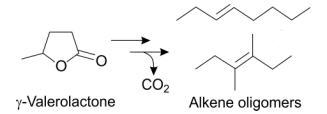
www.cen-online.org p.35, March 1, 2010
Shaped RuO2/SnO2–Al2O3 Catalyst for Large-Scale Stable Cl2 Production by HCl Oxidation
Cecilia Mondelli, Amol P. Amrute, Frank Krumeich,
Timm Schmidt, Javier Pérez-Ramírez
Nanostructured Cu/TiO2 Photocatalysts for H2 Production from Ethanol and Glycerol Aqueous Solutions
Tiziano Montini, Valentina Gombac, Laura Sordelli,
Juan José Delgado, Xiaowei Chen, Gianpiero Adami, Paolo Fornasiero
Alberto Boffi, Sandro Cacchi, Pierpaolo Ceci, Roberto Cirilli,
Giancarlo Fabrizi, Alessandro Prastaro, Sandra Niembro,
Alexandr Shafir, Adelina Vallribera
ChemSusChem
Heiner Friedrich, Shujing Guo, Petra E. de Jongh, Xiulian Pan,
Xinhe Bao, Krijn P. de Jong
Hydrolysis of Cellulose into Glucose by Magnetic Solid Acid
Da-ming Lai, Li Deng, Jiang Li, Bing Liao, Qing-xiang Guo, Yao Fu
Activation of Hematite Nanorod Arrays for Photoelectrochemical Water Splitting
Rachel Morrish, Mahfujur Rahman, J. M. Don MacElroy,
Colin A. Wolden
Advanced Synthesis & Catalysis
Grignard-Type Arylation of Aldehydes via a Rhodium-Catalyzed C—H Activation under Mild Conditions
Luo Yang, Camille A. Correia, Chao-Jun Li
Recent Advances in Palladium-Catalyzed Cascade Cyclizations
Tjøstil Vlaar, Eelco Ruijter, Romano V. A. Orru
Sylva Číhalová, Pawel Dziedzic, Armando Córdova, Jan Veselý
Angewandte Chemie IE
Tracing the Hydrogen Source of Hydrocarbons Formed by Vanadium
Nitrogenase
Chi Chung Lee, Yilin Hu, Markus W. Ribbe
Nanocomposites of Ag2S and Noble Metals
Jun Yang, Jackie Y. Ying
Kathrin Junge, Matthias Beller
Chemistry – A European Journal
Squaramides: Bridging from Molecular Recognition to Bifunctional
Organocatalysis
José Alemán, Alejandro Parra, Hao Jiang, Karl Anker Jørgensen
Sebastian Bähn, Sebastian Imm, Lorenz Neubert, Min Zhang,
Helfried Neumann, Matthias Beller
Chemistry – An Asian Journal
Nickel-Catalyzed Allylic Substitution of Simple Alkenes
Ryosuke Matsubara, Timothy F. Jamison
Ryo Yazaki, Naoya Kumagai, Masakatsu Shibasaki
Helvetica Chimica Acta
Krystyna Patora-Komisarska, Meryem Benohoud, Hayato Ishikawa,
Dieter Seebach, Yujiro Hayashi
Luigi Rumi, Gil M. Scheuermann, Rolf Mülhaupt, Willi Bannwarth
Chunan Ma, Zhaoyang Chen, Fengming Zhao
Applied Organometallic Chemistry
Ying Wang, Mei Wang, Lin Wang, Yu Wang, Xiuna Wang,
Licheng Sun
Journal of Physical Organic Chemistry
Matthew R. Siebert, Dean J. Tantillo
Niobium oxide solid catalyst: esterification of fatty acids and modeling for biodiesel production
Jussara de Araújo Gonçalves, André Luis Dantas Ramos,
Layla L. L. Rocha, Anderson Kurunczi Domingos, Robson S. Monteiro, José Sotolongo Peres, Nelson C. Furtado, Carlton A. Taft,
Donato A. G. Aranda
Israel Journal of Chemistry
Jean-François Lemonnier, Sylvain Duval, Sébastien Floquet,
Emmanuel Cadot
Macromolecular Rapid Communications
Mitsuo Sawamoto et al.
Well-defined Syndiotactic Polystyrene-b-Atactic Polystyrene Stereoblock Polymers
Jean-Francois Carpentier et al.
Macromolecular Reaction Engineering
Kiwamu Tonosaki, Toshiaki Taniike and Minoru Terano
Ahmad Alshaiban and João B. P. Soares
Macromolecular Chemistry & Physics
Ni-Catalyzed Polymerization of Poly(3-alkoxythiophene)s
Karlien Van den Bergh, Julien De Winter, Pascal Gerbaux,
Thierry Verbiest, Guy Koeckelberghs
Bismuth-Triflate-Catalyzed Polymerizations of ε-Caprolactone
Mohammed Lahcini, Hicham Qayouh, Takao Yashiro,
Steffen M. Weidner and Hans R. Kricheldorf
Macromolecular Theory & Simulation
Fluorine Interactions in a Post-Metallocene Titanium Catalyst: An ab initio Study
Vincenzo Villani and Gaetano Giammarino
Chemical Engineering & Technology
Comprehensive Polymerization Model for Fischer-Tropsch
Synthesis
Antonio B. Fontenelle Jr., Fabiano A. N. Fernandes
TPD-TG-MS Investigations of the Catalytic Conversion of Glycerol over MOx-Al2O3-PO4 Catalysts
Wladimir Suprun, Michal Lutecki, Helmut Papp
Chemie Ingenieur Technik
Georg Nickerl, Antje Henschel, Ronny Grünker, Kristina Gedrich,
Stefan Kaskel
European Journal of Organic Chemistry
Transition Metal-Catalyzed Formation of N-Heterocycles via Aryl- or Vinyl C–H Bond Amination
Benjamin J. Stokes, Tom G. Driver
Mariano A. Fernández-Zúmel, Charlotte Buron, Kay Severin
European Journal of Inorganic Chemistry
José María Muñoz-Molina, Tomás R. Belderrain and
Pedro J. Pérez
Bifunctional Mesoporous Silica Catalyst for C–C Bond Forming
Tandem Reactions
Krishna K. Sharma, Ankush V. Biradar, Sayantani Das and
Tewodros Asefa
The Chemical Record
Keiji Maruoka
ASIA Pacific Journal of Chemical Engineering
Application of clean technologies using electrochemistry in ionic liquids
A.P. Doherty, L. Diaconu, E. Marley, P. L. Spedding,
R. Barhdadi, M. Troupel
Cobalt(I)-catalyzed reactions for the synthesis of acyclic 1,4-dienes-genesis of two synthetic methods
Hilt, Gerhard
Synlett (2011), (12), 1654-1659. DOI:10.1055/s-0030-1260800
NHC-NiH reactions with simple olefins: advances in hydroalkenylation, polymerization, and ionic-liquid synthesis
Ho, Chun-Yu; He, Lisi; Chan, Chun-Wa
Synlett (2011), (12), 1649-1653. DOI:10.1055/s-0030-1260799
A green route to nitrogen-containing groups: the acrylonitrile cross-metathesis and applications to plant oil derivatives
Miao, Xiaowei; Dixneuf, Pierre H.; Fischmeister, Cedric; Bruneau, Christian
Green Chemistry (2011), 13(9), 2258-2271. DOI:10.1039/c1gc15377c
Challenges and breakthroughs in transition metal catalyzed copolymerization of polar and non-polar olefins
Campora, Juan; Brasse, Mikael
Catalysis by Metal Complexes (2011), 36 (Olefin Upgrading
Catalysis by Nitrogen-Based Metal Complexes II), 199-261.
Biomimetic Catalysis
Marchetti, Louis; Levine, Mindy
ACS Catalysis (2011), 1(9), 1090-1118. DOI:10.1021/cs200171u
Recent advances in vanadium catalyzed oxygen transfer reactions
Licini, Giulia; Conte, Valeria; Coletti, Alessia; Mba, Miriam;
Zonta, Cristiano
Coordination Chemistry Reviews (2011), 255(19-20),
2345-2357. DOI:10.1016/j.ccr.2011.05.004
Aerobic oxidation of organic compounds catalyzed by vanadium compounds
Kirihara, Masayuki
Coordination Chemistry Reviews (2011), 255(19-20), 2281-2302. DOI:10.1016/j.ccr.2011.04.001
Effect of size of catalytically active phases in the dehydrogenation of alcohols and the challenging selective oxidation of hydrocarbons
Zhang, Qinghong; Deng, Weiping; Wang, Ye
Chemical Communications (Cambridge, United Kingdom) (2011), 47(33), 9275-9292. DOI:10.1039/c1cc11723h
Nanoparticles for hydrogen generation
Bunker, Christopher E.; Smith, Marcus J.
Journal of Materials Chemistry (2011), 21(33), 12173-12180. DOI:10.1039/c1jm10856e
A review of subcritical water as a solvent and its utilisation for the processing of hydrophobic organic compounds
Carr, Adam G.; Mammucari, Raffaella; Foster, N. R.
Chemical Engineering Journal (Amsterdam, Netherlands) (2011), 172(1), 1-17. DOI:10.1016/j.cej.2011.06.007
Gold catalysis: Particle size or promoting oxide morphology?
Guczi, Lazlo; Beck, Andrea; Benko, Timea; Paszti, Zotltan
Materials Research Society Symposium Proceedings (2011), 1351 (Surfaces and Nanomaterials for Catalysis through In-Situ or Ex-Situ Studies), DOI:10.1557/opl.2011.1168
New catalytic performances of ruthenium and rhodium complexes directed toward organic synthesis with high atom efficiency
Kondo, Teruyuki
Bulletin of the Chemical Society of Japan (2011), 84(5), 441-458. DOI:10.1246/bcsj.20110019
Recent advances in polyolefin technology
Qiao, Jinliang; Guo, Meifang; Wang, Liangshi; Liu, Dongbing;
Zhang, Xiaofan; Yu, Luqiang; Song, Wenbo; Liu, Yiqun
Polymer Chemistry (2011), 2(8), 1611-1623. DOI:10.1039/c0py00352b
Recent advances in the chemistry of Group 4 metal complexes incorporating [OSSO]-type bis(phenolato) ligands as post-metallocene catalysts
Nakata, Norio; Toda, Tomoyuki; Ishii, Akihiko
Polymer Chemistry (2011), 2(8), 1597-1610. DOI:10.1039/c1py00058f
Bimetallic catalysts for the Fischer-Tropsch reaction
Calderone, V. Roberto; Shiju, N. Raveendran; Ferre,
Daniel Curulla; Rothenberg, Gadi
Green Chemistry (2011), 13(8), 1950-1959. DOI:10.1039/c0gc00919a
CO dissociation on Ru and Co surfaces: The initial step in the Fischer-Tropsch synthesis
Shetty, Sharan; van Santen, Rutger A.
Catalysis Today (2011), 171(1), 168-173. DOI:10.1016/j.cattod.2011.04.006
Catalysis for conversion of biomass to fuels via pyrolysis and gasification: A review
Bulushev, Dmitri A.; Ross, Julian R. H.
Catalysis Today (2011), 171(1), 1-13. DOI:10.1016/j.cattod.2011.02.005
Kinetics of hydrolysis of sodium borohydride for hydrogen production in fuel cell applications: A review
Retnamma, Rajasree; Novais, Augusto Q.; Rangel, C. M.
International Journal of Hydrogen Energy (2011), 36(16),
9772-9790. DOI:10.1016/j.ijhydene.2011.04.223
Review of heterogeneous catalysts for sub- and supercritical water gasification of biomass and wastes
Azadi, Pooya; Farnood, Ramin
International Journal of Hydrogen Energy (2011), 36(16),
9529-9541. DOI:10.1016/j.ijhydene.2011.05.081
Engineering of Biocatalysts: from Evolution to Creation
Quin, Maureen B.; Schmidt-Dannert, Claudia
ACS Catalysis (2011), 1(9), 1017-1021. DOI:10.1021/cs200217t
Anatase TiO2 with Dominant High-Energy {001} Facets: Synthesis, Properties, and Applications
By Liu, Shengwei; Yu, Jiaguo; Jaroniec, Mietek
From Chemistry of Materials (2011), 23(18), 4085-4093. DOI:10.1021/cm200597m
Platinum metals in the catalytic asymmetric isomerization of allylic alcohols
Mantilli, Luca; Mazet, Clement
Chemistry Letters (2011), 40(4), 341-344. DOI:10.1246/cl.2011.341
Bifunctional catalysis. A bridge from CO2 to methanol
Dixneuf, Pierre H.
Nature Chemistry (2011), 3(8), 578-579. DOI:10.1038/nchem.1103
Inexpensive copper/iron-cocatalyzed reactions
Su, Yijin; Jia, Wei; Jiao, Ning
Synthesis (2011), (11), 1678-1690. DOI:10.1055/s-0030-1260028
Transition Metal-Catalyzed Formation of N-Heterocycles via Aryl- or Vinyl C-H Bond Amination
Stokes, Benjamin J.; Driver, Tom G.
European Journal of Organic Chemistry (2011), 2011(22),
4071-4088. DOI:10.1002/ejoc.201100150
Biomass to fuels: The role of zeolite and mesoporous materials
Perego, Carlo; Bosetti, Aldo
Microporous and Mesoporous Materials (2011), 144(1-3), 28-39. DOI:10.1016/j.micromeso.2010.11.034
Zeolite films and membranes. Emerging applications
Pina, M. P.; Mallada, R.; Arruebo, M.; Urbiztondo, M.; Navascues, N.; de la Iglesia, O.; Santamaria, J.
Microporous and Mesoporous Materials (2011), 144(1-3), 19-27. DOI:10.1016/j.micromeso.2010.12.003
Translating new materials discoveries in zeolite research to commercial manufacture
Zones, S. I.
From Microporous and Mesoporous Materials (2011), 144(1-3), 1-8. DOI:10.1016/j.micromeso.2011.03.039
Fluidized bed synthesis of carbon nanotubes - A review
Dasgupta, Kinshuk; Joshi, Jyeshtharaj B.; Banerjee, Srikumar
Chemical Engineering Journal (Amsterdam, Netherlands) (2011), 171(3), 841-869. DOI:10.1016/j.cej.2011.05.038
Cellulose reactivity and glycosidic bond cleavage in aqueous phase by catalytic and non catalytic transformations
Cabiac, Amandine; Guillon, Emmanuelle; Chambon, Flora; Pinel, Catherine; Rataboul, Franck; Essayem, Nadine
From Applied Catalysis, A: General (2011), 402(1-2), 1-10. DOI:10.1016/j.apcata.2011.05.029
Organometallic frustrated Lewis pair chemistry
Erker, Gerhard
Dalton Transactions (2011), 40(29), 7475-7483. DOI:10.1039/c1dt10152h
Metal-Ligand Cooperation by Aromatization-Dearomatization: A New Paradigm in Bond Activation and "Green" Catalysis
Gunanathan, Chidambaram; Milstein, David
Accounts of Chemical Research (2011), 44(8), 588-602. DOI:10.1021/ar2000265
Development of transition-metal-catalyzed cycloaddition reactions leading to polycarbocyclic systems
Gulias, Moises; Lopez, Fernando; Mascarenas, Jose L.
Pure and Applied Chemistry (2011), 83(3), 495-506. DOI:10.1351/PAC-CON-10-10-23
Use of zeolites for greener and more para-selective electrophilic aromatic substitution reactions
Smith, Keith; El-Hiti, Gamal A.
Green Chemistry (2011), 13(7), 1579-1608. DOI:10.1039/c0gc00689k
Asymmetric Catalysis with Chiral Porous Metal-Organic Frameworks: Critical Issues
Wang, Cheng; Zheng, Min; Lin, Wenbin
Journal of Physical Chemistry Letters (2011), 2(14), 1701-1709. DOI:10.1021/jz200492d
Recent Advances in Amine Synthesis by Catalytic Hydroaminomethylation of Alkenes
Crozet, Delphine; Urrutigoity, Martine; Kalck, Philippe
ChemCatChem (2011), 3(7), 1102-1118. DOI:10.1002/cctc.201000411
Towards Conducting Metal-Organic Frameworks
D'Alessandro, Deanna M.; Kanga, Jehan R. R.; Caddy, James S.
Australian Journal of Chemistry (2011), 64(6), 718-722. DOI:10.1071/CH11039
Induced Intramolecularity: An Effective Strategy in Catalysis
Tan, Kian L.
ACS Catalysis (2011), 1(8), 877-886. DOI:10.1021/cs2002302
The Effects of Confinement inside Carbon Nanotubes on Catalysis
Pan, Xiulian; Bao, Xinhe
Accounts of Chemical Research (2011), 44(8), 553-562. DOI:10.1021/ar100160t
Biocatalytic Promiscuity
Humble, Maria Svedendahl; Berglund, Per
European Journal of Organic Chemistry (2011), 2011(19),
3391-3401. DOI:10.1002/ejoc.201001664
Duality in Catalyst Design: The Synergistic Coupling of Steric and Stereoelectronic Control over Polyolefin Microstructure
Sita, Lawrence R.
Angewandte Chemie, International Edition (2011), 50(31),
6963-6965. DOI:10.1002/anie.201101913
Catalytic hydrolysis of ammonia borane for chemical hydrogen storage
Jiang, Hai-Long; Xu, Qiang
Catalysis Today (2011), 170(1), 56-63. DOI:10.1016/j.cattod.2010.09.019
Metal-biomolecule frameworks (MBioFs)
Imaz, Inhar; Rubio-Martinez, Marta; An, Jihyun; Sole-Font, Isabel;
Rosi, Nathaniel L.; Maspoch, Daniel
Chemical Communications (Cambridge, United Kingdom) (2011), 47(26), 7287-7302. DOI:10.1039/c1cc11202c
Design strategies for engineering selectivity in bio-inspired heterogeneous catalysts
Xuereb, David J.; Raja, Robert
Catalysis Science & Technology (2011), 1(4), 517-534. DOI:10.1039/c0cy00088d
Surface Science and Model Catalysis with Ionic Liquid-Modified Materials
Steinrueck, H.-P.; Libuda, J.; Wasserscheid, P.; Cremer, T.; Kolbeck, C.; Laurin, M.; Maier, F.; Sobota, M.; Schulz, P. S.; Stark, M.
Advanced Materials (Weinheim, Germany) (2011), 23(22-23), 2571-2587. DOI:10.1002/adma.201100211
Well-Defined Bifunctional Iron Catalysts for the Hydrogenation of Ketones: Iron, the New Ruthenium
Bauer, Gerald; Kirchner, Karl A.
Angewandte Chemie, International Edition (2011), 50(26),
5798-5800. DOI:10.1002/anie.201101579
Thermal alterations of zeolite catalysts
Guisnet, M.; Cerqueira, H. S.; Ribeiro, F. Ramoa
Catalytic Science Series (2011), 9 (Deactivation and Regeneration of Zeolite Catalysts), 139-150.
Poisoning of zeolite catalysts
Guisnet, M.
Catalytic Science Series (2011), 9 (Deactivation and Regeneration of Zeolite Catalysts), 101-114.
Methods to simulate catalyst deactivation
Cerqueira, H. S.
Catalytic Science Series (2011), 9 (Deactivation and Regeneration of Zeolite Catalysts), 41-49.
Zeolites as models for understanding catalyst deactivation and regeneration
Guisnet, M.; Fonseca, N. G.; Ribeiro, F. Ramoa
Catalytic Science Series (2011), 9 (Deactivation and Regeneration of Zeolite Catalysts), 19-38.
Palladium(III) in synthesis and catalysis
Powers, David C.; Ritter, Tobias
Topics in Organometallic Chemistry (2011), 35 (Higher Oxidation State Organopalladium and Platinum Chemistry), 129-156. DOI:10.1007/978-3-642-17429-2_6
Iridium-catalyzed hydrogen transfer reactions
Saidi, Ourida; Williams, Jonathan M. J.
Topics in Organometallic Chemistry (2011), 34 (Iridium Catalysis), 77-106. DOI:10.1007/978-3-642-15334-1_4
Porous Organic Polymers in Catalysis: Opportunities and Challenges
Kaur, Parminder; Hupp, Joseph T.; Nguyen, SonBinh T.
ACS Catalysis (2011), 1(7), 819-835. DOI:10.1021/cs200131g
Crystal facet engineering of semiconductor photocatalysts: motivations, advances and unique properties
Liu, Gang; Yu, Jimmy C.; Lu, Gao Qing; Cheng, Hui-Ming
Chemical Communications (Cambridge, United Kingdom) (2011), 47(24), 6763-6783. DOI:10.1039/c1cc10665a
Catalytic applications of amorphous alloys: Expectations, achievements, and disappointments
By Molnar, Arpad
Applied Surface Science (2011), 257(19), 8151-8164. DOI:10.1016/j.apsusc.2010.12.046
What we have learned from studies on chemical properties of amorphous alloys?
Hashimoto, Koji
Applied Surface Science (2011), 257(19), 8141-8150. DOI:10.1016/j.apsusc.2010.12.142
Advanced electron microscopy investigation of ceria-zirconia-based catalysts
Lopez-Haro, M.; Perez-Omil, J. A.; Hernandez-Garrido, J. C.;
Trasobares, S.; Hungria, A. B.; Cies, J. M.; Midgley, P. A.;
Bayle-Guillemaud, P.; Martinez-Arias, A.; Bernal, S.; et al
ChemCatChem (2011), 3(6), 1015-1027. DOI:10.1002/cctc.201000306
Advanced electron microscopy of metal-support interactions in supported metal catalysts
Liu, Jingyue
ChemCatChem (2011), 3(6), 934-948. DOI:10.1002/cctc.201100090
New strategies for e-beam characterization of catalysts
Howie, A.
ChemCatChem (2011), 3(6), 961-964. DOI:10.1002/cctc.201000171
Toward redox framework single site zeolite catalysts
Dzwigaj, Stanislaw; Che, Michel
Catalysis Today (2011), 169(1), 232-241. DOI:10.1016/j.cattod.2011.01.035
Organogold Reactivity with Palladium, Nickel, and Rhodium: Transmetalation, Cross-Coupling, and Dual Catalysis
Hirner, Joshua J.; Shi, Yi-Li; Blum, Suzanne A.
Accounts of Chemical Research (2011), 44(8), 603-613. DOI:10.1021/ar200055y
Design of Novel Structured Gold Nanocatalysts
Ma, Zhen; Dai, Sheng
ACS Catalysis (2011), 1(7), 805-818. DOI:10.1021/cs200100w
Catalytic and molecular separation properties of Zeogrids and Zeotiles
Martens, Johan A.; Thybaut, Joris W.; Denayer, Joeri F. M.;
Sree, Sreeprasanth Pulinthanathu; Aerts, Alexander; Reyniers,
Marie-Francoise; Van Speybroeck, Veronique; Waroquier, Michel; Buekenhoudt, Anita; Vankelecom, Ivo; et al.
Catalysis Today (2011), 168(1), 17-27. DOI:10.1016/j.cattod.2011.01.036
Carbon nanotubes and their composites in electrochemical applications
Lota, Grzegorz; Fic, Krzysztof; Frackowiak, Elzbieta
Energy & Environmental Science (2011), 4(5), 1592-1605. DOI:10.1039/c0ee00470g
Polymer-supported nanocomposites for environmental application: A review
Zhao, Xin; Lv, Lu; Pan, Bingcai; Zhang, Weiming; Zhang, Shujuan; Zhang, Quanxing
Chemical Engineering Journal (Amsterdam, Netherlands) (2011), 170(2-3), 381-394. DOI:10.1016/j.cej.2011.02.071
Low-platinum and platinum-free catalysts for the oxygen reduction reaction at fuel cell cathodes
Morozan, Adina; Jousselme, Bruno; Palacin, Serge
Energy & Environmental Science (2011), 4(4), 1238-1254. DOI:10.1039/c0ee00601g
Catalytic cracking of edible and non-edible oils for the production of biofuels
Taufiqurrahmi, Niken; Bhatia, Subhash
Energy & Environmental Science (2011), 4(4), 1087-1112. DOI:10.1039/c0ee00460j
Cross-Coupling Reactions Of Organoboranes: An Easy Way To Construct C-C Bonds (Nobel Lecture)
Suzuki, Akira
Angewandte Chemie, International Edition (2011), 50(30),
6722-6737. DOI:10.1002/anie.201101379
The Bridge Connecting Gas-Phase and Solution Chemistries
Coelho, Fernando; Eberlin, Marcos N.
Angewandte Chemie, International Edition (2011), 50(23),
5261-5263. DOI:10.1002/anie.201008082
Functional Micro/Nanostructures: Simple Synthesis and Application in Sensors, Fuel Cells, and Gene Delivery
Guo, Shaojun; Wang, Erkang
Accounts of Chemical Research (2011), 44(7), 491-500. DOI:10.1021/ar200001m
Current Theoretical Challenges in Proton-Coupled Electron Transfer: Electron-Proton Nonadiabaticity, Proton Relays, and Ultrafast Dynamics
Hammes-Schiffer, Sharon
Journal of Physical Chemistry Letters (2011), 2(12), 1410-1416. DOI:10.1021/jz200277p
Deactivation and regeneration of wet air oxidation catalysts
Keav, Sylvain; Barbier, Jacques; Duprez, Daniel
Catalysis Science & Technology (2011), 1(3), 342-353. DOI:10.1039/c0cy00085j
Unique catalytic features of Ag nanoclusters for selective NOx reduction and green chemical reactions
Shimizu, Kenichi; Sawabe, Kyoichi; Satsuma, Atsushi
Catalysis Science & Technology (2011), 1(3), 331-341. DOI:10.1039/c0cy00077a
Structure sensitivity and nanoscale effects in electrocatalysis
Koper, Marc T. M.
Nanoscale (2011), 3(5), 2054-2073. DOI:10.1039/c0nr00857e
Utilisation of biomass for sustainable fuels and chemicals: Molecules, methods and metrics
Sheldon, Roger A.
Catalysis Today (2011), 167(1), 3-13. DOI:10.1016/j.cattod.2010.10.100
Current perspectives on microwave-enhanced reactions of monosaccharides promoted by heterogeneous catalysts
Richel, Aurore; Laurent, Pascal; Wathelet, Bernard; Wathelet, Jean-Paul; Paquot, Michel
Catalysis Today (2011), 167(1), 141-147. DOI:10.1016/j.cattod.2011.01.001
Role of solvents in coordination supramolecular systems
Li, Cheng-Peng; Du, Miao
Chemical Communications (Cambridge, United Kingdom) (2011), 47(21), 5958-5972. DOI:10.1039/c1cc10935a
Catalysis involved in dimethyl ether production and as an intermediate in the generation of hydrocarbons via Fischer-Tropsch synthesis and MTG process
Sousa-Aguiar, Eduardo Falabella; Appel, Lucia Gorenstin
Catalysis (2011), 23, 284-315.
DOI:10.1039/9781849732772-00284
Precious metal catalysts for deep hydrodesulfurization
Kuhn, John N.
Catalysis (2011), 23, 96-138.
DOI:10.1039/9781849732772-00096
Salt-type organic acids: a class of green acidic catalysts in Organic transformations
Wang, Bo; Zhou, Shuai; Sun, Yongchang; Xu, Feng; Sun, Runcang
Current Organic Chemistry (2011), 15(9), 1392-1422.
Heterogeneous Catalytic Conversion of Dry Syngas to Ethanol and Higher Alcohols on Cu-Based Catalysts
Gupta, Mayank; Smith, Miranda L.; Spivey, James J.
ACS Catalysis (2011), 1(6), 641-656. DOI:10.1021/cs2001048
Polymers for Green C-C Couplings
Albeniz, Ana C.; Carrera, Nora
European Journal of Inorganic Chemistry (2011), (15),
2347-2360. DOI:10.1002/ejic.201100162
Membrane reactors for fuel cell quality hydrogen through WGSR - Review of their status, challenges and opportunities
Babita, K.; Sridhar, S.; Raghavan, K. V.
International Journal of Hydrogen Energy (2011), 36(11),
6671-6688. DOI:10.1016/j.ijhydene.2011.02.107
Molecular and engineering perspectives of the biocatalysis interface to chemical synthesis
Wohlgemuth, R.
Chemical and Biochemical Engineering Quarterly (2011), 25(1), 125-134.
Synthesis of high-reactive facets dominated anatase TiO2
Wen, Ci Zhang; Jiang, Hai Bo; Qiao, Shi Zhang; Yang, Hua Gui; Lu, Gao Qing
Journal of Materials Chemistry (2011), 21(20), 7052-7061. DOI:10.1039/c1jm00068c
(Imido)vanadium Complexes as Efficient Catalyst Precursors for Olefin Polymerization/Oligomerization
Zhang, Shu; Nomura, Kotohiro
Catalysis Surveys from Asia (2011), 15(2), 127-133. DOI:10.1007/s10563-011-9116-x
Semiconductor nanostructure-based photoelectrochemical water splitting: A brief review
Lin, Yongjing; Yuan, Guangbi; Liu, Rui; Zhou, Sa; Sheehan, Stafford W.; Wang, Dunwei
Chemical Physics Letters (2011), 507(4-6), 209-215. DOI:10.1016/j.cplett.2011.03.074
Inorganic molecular sieves: Preparation, modification and industrial application in catalytic processes
Martinez, Cristina; Corma, Avelino
Coordination Chemistry Reviews (2011), 255(13-14),
1558-1580. DOI:10.1016/j.ccr.2011.03.014
Recent advances in oxidation catalysis using ionic liquids as solvents
Betz, Daniel; Altmann, Philipp; Cokoja, Mirza; Herrmann,
Wolfgang A.; Kuehn, Fritz E.
Coordination Chemistry Reviews (2011), 255(13-14),
1518-1540. DOI:10.1016/j.ccr.2010.12.004
Recent advances and actual challenges in late transition metal catalyzed hydrosilylation of olefins from an industrial point of view
Troegel, Dennis; Stohrer, Juergen
Coordination Chemistry Reviews (2011), 255(13-14),
1440-1459. DOI:10.1016/j.ccr.2010.12.025
Electric Power and Syngas from Methane - an Energy-Efficient Combination of a Single-Chamber Fuel Cell and Downstream
Catalytic Equilibration
Maier, Wilhelm F.
Angewandte Chemie, International Edition (2011), 50(19),
4265-4267. DOI:10.1002/anie.201100597
Electrocatalyst design from first principles: A hydrogen-production catalyst inspired by nature
Zipoli, Federico; Car, Roberto; Cohen, Morrel H.; Selloni, Annabella
Catalysis Today (2011), 165(1), 160-170. DOI:10.1016/j.cattod.2010.12.030
Pharmacological potential of cerium oxide nanoparticles
Celardo, Ivana; Pedersen, Jens Z.; Traversa, Enrico; Ghibelli, Lina
Nanoscale (2011), 3(4), 1411-1420. DOI:10.1039/c0nr00875c
Challenge and progress. Palladium-catalyzed sp3 C-H activation
Li, Hu; Li, Bi-Jie; Shi, Zhang-Jie
Catalysis Science & Technology (2011), 1(2), 191-206. DOI:10.1039/c0cy00076k
Progress in sodium borohydride as a hydrogen storage material: Development of hydrolysis catalysts and reaction systems
Muir, Sean S.; Yao, Xiangdong
International Journal of Hydrogen Energy (2011), 36(10),
5983-5997. DOI:10.1016/j.ijhydene.2011.02.032
Recent Advances in Palladium-Catalyzed Cascade Cyclizations
Vlaar, Tjostil; Ruijter, Eelco; Orru, Romano V. A.
Advanced Synthesis & Catalysis (2011), 353(6), 809-841. DOI:10.1002/adsc.201000979
Recent developments on task specific ionic liquids
Chaturvedi, Devdutt
Current Organic Chemistry (2011), 15(8), 1236-1248.
C-H activation is a Rieske business
Bruner, Steven D.
Nature Chemistry (2011), 3(5), 342-343. DOI:10.1038/nchem.1038
Metal-oxide interfaces. Where the action is
Stair, Peter C.
Nature Chemistry (2011), 3(5), 345-346. DOI:10.1038/nchem.1037
Supramolecular ligand-ligand and ligand-substrate interactions for highly selective transition metal catalysis
Carboni, Stefano; Gennari, Cesare; Pignataro, Luca; Piarulli, Umberto
Dalton Transactions (2011), 40(17), 4355-4373. DOI:10.1039/c0dt01517b
Catalytic nitrate removal from water, past, present and future perspectives
Barrabes, Noelia; Sa, Jacinto
Applied Catalysis, B: Environmental (2011), 104(1-2), 1-5. DOI:10.1016/j.apcatb.2011.03.011
Renewable fuels via catalytic hydrodeoxygenation
Choudhary, T. V.; Phillips, C. B.
Applied Catalysis, A: General (2011), 397(1-2), 1-12. DOI:10.1016/j.apcata.2011.02.025
Homogeneous catalysis using iron complexes. Recent developments in selective reductions
Junge, Kathrin; Schroeder, Kristin; Beller, Matthias
Chemical Communications (Cambridge, United Kingdom) (2011), 47(17), 4849-4859. DOI:10.1039/c0cc05733a
Oils and Fats as Renewable Raw Materials in Chemistry
Biermann, Ursula; Bornscheuer, Uwe; Meier, Michael A. R.;
Metzger, Juergen O.; Schaefer, Hans J.
Angewandte Chemie, International Edition (2011), 50(17),
3854-3871, S3954/1-S3954/36. DOI:10.1002/anie.201002767
Microwave photochemistry and photocatalysis. Part 1: principles and overview
Cirkva, Vladimir; Relich, Stanislav
Current Organic Chemistry (2011), 15(2), 248-264. DOI:10.2174/138527211793979844
Hydrogen Lean-DeNOx as an Alternative to the Ammonia and Hydrocarbon Selective Catalytic Reduction (SCR)
Savva, Petros G.; Costa, Costas N.
Catalysis Reviews - Science and Engineering (2011), 53(2),
91-151. DOI:10.1080/01614940.2011.557964
Phase transfer catalysis in phosphorus chemistry
Ilia, Gheorghe; Macarie, Lavinia; Balint, Erika; Keglevich, Gyorgy
Catalysis Reviews - Science and Engineering (2011), 53(2), 152-198. DOI:10.1080/01614940.2011.569235
Room-temperature ionic liquids: Solvents for synthesis and catalysis. 2
Hallett, Jason P.; Welton, Tom
Chemical Reviews (Washington, DC, United States) (2011), 111(5), 3508-3576. DOI:10.1021/cr1003248
Preparation of metal "nanosalts" and their application in catalysis: heterogeneous and homogeneous pathways
Ananikov, Valentine P.; Beletskaya, Irina P.
Dalton Transactions (2011), 40(16), 4011-4023. DOI:10.1039/c0dt01277g
Recent applications of carbon-based nanomaterials in analytical chemistry: Critical review
Scida, Karen; Stege, Patricia W.; Haby, Gabrielle; Messina, German A.; Garcia, Carlos D.
Analytica Chimica Acta (2011), 691(1-2), 6-17. DOI:10.1016/j.aca.2011.02.025
Green polymer chemistry: Precision synthesis of novel multifunctional poly(ethylene glycol)s using enzymatic catalysis
Puskas, Judit E.; Seo, Kwang Su; Sen, Mustafa Y.
European Polymer Journal (2011), 47(4), 524-534. DOI:10.1016/j.eurpolymj.2010.10.015
Ligands that Store and Release Electrons during Catalysis
Dzik, Wojciech I.; van der Vlugt, Jarl Ivar; Reek, Joost N. H.;
de Bruin, Bas
Angewandte Chemie, International Edition (2011), 50(15),
3356-3358. DOI:10.1002/anie.201006778
Zeolite-catalyzed biomass conversion to fuels and chemicals
Taarning, Esben; Osmundsen, Christian M.; Yang, Xiaobo; Voss,
Bodil; Andersen, Simon I.; Christensen, Claus H.
Energy & Environmental Science (2011), 4(3), 793-804. DOI:10.1039/c004518g
Advanced carbon aerogels for energy applications
Biener, Juergen; Stadermann, Michael; Suss, Matthew;
Worsley, Marcus A.; Biener, Monika M.; Rose, Klint A.;
Baumann, Theodore F.
Energy & Environmental Science (2011), 4(3), 656-667. DOI:10.1039/c0ee00627k
Molybdenum cofactor biosynthesis in plants and humans
Mendel, Ralf R.; Schwarz, Guenter
Coordination Chemistry Reviews (2011), 255(9-10), 1145-1158. DOI:10.1016/j.ccr.2011.01.054
Coordination chemistry of corroles with focus on main group elements
Aviv-Harel, Iris; Gross, Zeev
Coordination Chemistry Reviews (2011), 255(7-8), 717-736. DOI:10.1016/j.ccr.2010.09.013
Catalytic control of emissions from cars
Twigg, Martyn V.
Catalysis Today (2011), 163(1), 33-41. DOI:10.1016/j.cattod.2010.12.044
Nickel Nanoparticles in Hydrogen Transfer Reactions
Alonso, Francisco; Riente, Paola; Yus, Miguel
Accounts of Chemical Research (2011), 44(5), 379-391. DOI:10.1021/ar1001582
TiO2 Nanotubes: Synthesis and Applications
Roy, Poulomi; Berger, Steffen; Schmuki, Patrik
Angewandte Chemie, International Edition (2011), 50(13),
2904-2939. DOI:10.1002/anie.201001374
Performance of calcium oxide as a heterogeneous catalyst in biodiesel production: A review
Boey, Peng-Lim; Maniam, Gaanty Pragas; Hamid, Shafida Abd
Chemical Engineering Journal (Amsterdam, Netherlands) (2011), 168(1), 15-22. DOI:10.1016/j.cej.2011.01.009
Progress in One-step Amination of Long-chain Fatty Alcohols with Dimethylamine: Development of Key Technologies for Industrial Applications, Innovations, and Future Outlook
Kimura, Hiroshi
Catalysis Reviews - Science and Engineering (2011), 53(1), 1-90. DOI:10.1080/01614940.2011.556913
Rapid and highly selective conversion of biomass into value-added products in hydrothermal conditions: chemistry of acid/base-catalyzed and oxidation reactions
Jin, Fangming; Enomoto, Heiji
Energy & Environmental Science (2011), 4(2), 382-397. DOI:10.1039/c004268d
Pore-scale modeling of two-phase transport in polymer electrolyte fuel cells-progress and perspective
Mukherjee, Partha P.; Kang, Qinjun; Wang, Chao-Yang
Energy & Environmental Science (2011), 4(2), 346-369. DOI:10.1039/b926077c
Clean liquid fuels from direct coal liquefaction: chemistry, catalysis, technological status and challenges
Vaskeddy, Sivakumar; Morreale, Bryan; Cugini, Anthony; Song, Chunshan; Spivey, James J.
Energy & Environmental Science (2011), 4(2), 311-345. DOI:10.1039/c0ee00097c
Recent advances in non-precious metal catalysis for oxygen-reduction reaction in polymer electrolyte fuel cells
Jaouen, Frederic; Proietti, Eric; Lefevre, Michel; Chenitz, Regis;
Dodelet, Jean-Pol; Wu, Gang; Chung, Hoon Taek;
Johnston, Christina Marie; Zelenay, Piotr
Energy & Environmental Science (2011), 4(1), 114-130. DOI:10.1039/c0ee00011f
Catalytic routes for the conversion of biomass into liquid hydrocarbon transportation fuels
Serrano-Ruiz, Juan Carlos; Dumesic, James A.
Energy & Environmental Science (2011), 4(1), 83-99. DOI:10.1039/c0ee00436g
Platinum-Based Electrocatalysts with Core-Shell Nanostructures
Yang, Hong
Angewandte Chemie, International Edition (2011), 50(12),
2674-2676. DOI:10.1002/anie.201005868
The conversion of lignocellulosics to levulinic acid
Rackemann, Darryn W.; Doherty, William O. S.
Biofuels, Bioproducts & Biorefining (2011), 5(2), 198-214. DOI:10.1002/bbb.267
Chemistry of concerto molecular catalysis based on the metal/NH bifunctionality
Ikariya, Takao
Bulletin of the Chemical Society of Japan (2011), 84(1), 1-16. DOI:10.1246/bcsj.20100249
Bimetallic Nanocrystals: Liquid-Phase Synthesis and Catalytic Applications
Wang, Dingsheng; Li, Yadong
Advanced Materials (Weinheim, Germany) (2011), 23(9),
1044-1060. DOI:10.1002/adma.201003695
Surface Science Studies on Cobalt Fischer-Tropsch Catalysts
Wang, Zhou-jun; Yan, Zhen; Liu, Chang-jun; Goodman, D. W.
ChemCatChem (2011), 3(3), 551-559. DOI:10.1002/cctc.201000319
Catalysts for Hydrogen Production from Heavy Hydrocarbons
Navarro Yerga, Rufino. M.; Alvarez-Galvan, M. Consuelo;
Mota, Noelia; Villoria de la Mano, Jose A.; Al-Zahrani, Saeed M.; Fierro, Jose L. G.
ChemCatChem (2011), 3(3), 440-457. DOI:10.1002/cctc.201000315
Towards an Efficient Hydrogen Production from Biomass: A Review of Processes and Materials
Chen, De; He, Li
ChemCatChem (2011), 3(3), 490-511. DOI:10.1002/cctc.201000345
Fischer-Tropsch Synthesis over Molecular Sieve Supported Catalysts
Sun, Bo; Qiao, Minghua; Fan, Kangnian; Ulrich, Jeffrey; Tao, Franklin
ChemCatChem (2011), 3(3), 542-550. DOI:10.1002/cctc.201000352
Progresses in the Preparation of Coke Resistant Ni-based Catalyst for Steam and CO2 Reforming of Methane
Liu, Chang-jun; Ye, Jingyun; Jiang, Jiaojun; Pan, Yunxiang
ChemCatChem (2011), 3(3), 529-541. DOI:10.1002/cctc.201000358
Multicomponent reactions and ionic liquids: a perfect synergy for eco-compatible heterocyclic synthesis
Isambert, Nicolas; Duque, Maria del Mar Sanchez;
Plaquevent, Jean-Christophe; Genisson, Yves; Rodriguez, Jean;
Constantieux, Thierry
Chemical Society Reviews (2011), 40(3), 1347-1357. DOI:10.1039/c0cs00013b
Hydrogen Production by Catalytic Reforming of Liquid Hydrocarbons
Moon, Dong Ju
Catalysis Surveys from Asia (2011), 15(1), 25-36. DOI:10.1007/s10563-010-9105-5
Dimethyl Ether-Reforming Catalysts for Hydrogen Production
Faungnawakij, Kajornsak; Eguchi, Koichi
Catalysis Surveys from Asia (2011), 15(1), 12-24. DOI:10.1007/s10563-010-9103-7
Renewable hydrogen carrier - carbohydrate: constructing the carbon-neutral carbohydrate economy
Percival Zhang, Y.-H.; Mielenz, Jonathan R.
Energies (Basel, Switzerland) (2011), 4, 254-275. DOI:10.3390/en4010254
Supercritical methanol for fatty acid methyl ester production: A review
de Boer, Karne; Bahri, Parisa A.
Biomass and Bioenergy (2011), 35(3), 983-991. DOI:10.1016/j.biombioe.2010.11.037
A review of bio-diesel production processes
Andrade, J. E.; Perez, A.; Sebastian, P. J.; Eapen, D.
Biomass and Bioenergy (2011), 35(3), 1008-1020. DOI:10.1016/j.biombioe.2010.12.037
Ionogels, ionic liquid based hybrid materials
Le Bideau, Jean; Viau, Lydie; Vioux, Andre
Chemical Society Reviews (2011), 40(2), 907-925. DOI:10.1039/c0cs00059k
Advancements in solid acid catalysts for ecofriendly and economically viable synthesis of biodiesel
Sharma, Yogesh C.; Singh, Bhaskar; Korstad, John
Edited By: Yudin, Andrei K
Biofuels, Bioproducts & Biorefining (2011), 5(1), 69-92. DOI:10.1002/bbb.253
A review of recent advances on the effects of microstructural refinement and nano-catalytic additives on the hydrogen storage properties of metal and complex hydrides
Varin, Robert A.; Zbroniec, Leszek; Polanski, Marek;
Bystrzycki, Jerzy
Edited By: Yudin, Andrei K.
Energies (Basel, Switzerland) (2011), 4, 1-25. DOI:10.3390/en4010001
Green chemistry and engineering a versatile research perspective
Sharma, Sanjay K.; Mudhoo, Ackmez; Zhang, Wei
Edited By: Sharma, Sanjay Kumar; Mudhoo, Ackmez
Green Chemistry for Environmental Sustainability (2011), 1-52.
Приглашения на конференции
|
8-10 ноября 2011 г. |
|
|
14-17 ноября 2011 г. |
|
|
November 14-28, 2011 |
www.praiseworthyprize.it/conferences/CEAM-VF2011/ceam2011.htm |
|
16-17 ноября 2011 г. |
|
|
21-24 ноября 2011 г. |
|
|
November 28 – December 2, 2011 |
|
|
29-30 ноября 2011 г. |
|
|
December 4-8 2011 |
|
|
6-8 декабря 2011 г. |
|
|
8-10 декабря 2011 г. |
|
|
December 11-15, 2011 |
|
|
December 12-14, 2011 |
|
|
December 12-15, 2011 |
|
|
January 10-12, 2012 |
|
|
6-10 февраля 2012 г. |
|
|
March 5-7, 2012 |
|
|
18-23 марта 2012 г. |
|
|
April 1-4, 2012 |
|
|
April 10-13, 2012 |
|
|
April 20 – May 3, 2012 |
|
|
23-27 апреля 2012 г. |
|
|
April 30 – May 2, 2012 |
|
|
June 3-6, 2012 |
|
|
June 6-8, 2012 |
|
|
17-22 июня 2012 г. |
|
|
June 18-22, 2012 |
|
|
June 20-22, 2012 |
|
|
June 26-30, 2012 |
|
|
June 27-29, 2012 |
|
|
June 29-30, 2012 |
|
|
June 29-30, 2012 |
July 1-5, 2012 |
July 1-6, 2012 |
|
July 15-17, 2012 |
|
|
September 2-5, 2012 |
|
|
September 2-6, 2012 |
|
|
September 16-19, 2012 |
|
|
September 23-26, 2012 |
|
|
23-26 октября 2012 г. |
Издательство “Калвис” выпустило сборник, основой которого являются два тома книги, написанной выдающимся химиком ХХ в. академиком Владимиром Николаевичем Ипатьевым, а также ряд статей крупных ученых России, позволяющих оценить современное значение его трудов для мировой и отечественной науки. В сборник включены материалы государственных архивов: Архива РАН, Санкт-Петербургского филиала Архива РАН, Российского государственного архива экономики, впервые публикуемые в открытой печати. Сборник ориентирован на широкий круг читателей, интересующихся историей отечественной и мировой науки.
Академик В.Н. Ипатьев
В 2-х кн. М.: Калвис, 2011. 444 с.
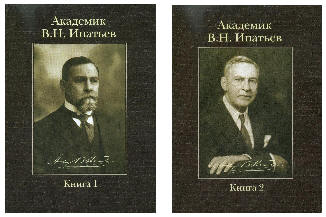 Академик В.Н. Ипатьев – один из основоположников каталитического органического синтеза, создатель теории и практики получения
высококачественных бензинов, его именем названы технологические схемы (“реакции Ипатьева”) и методы анализа (“бомба Ипатьева”). В России В.Н.
Ипатьев приобрел известность как ведущий специалист в химической промышленности, в частности, в производстве взрывчатых веществ и соединений
высокой энергии, а также в исследованиях по катализу органических реакций при высоком давлении. После приезда в США в 1931 году он сделал
ряд ключевых открытий в области катализа, которые обеспечили создание основ нефтеперерабатывающей и нефтехимической промышленности, к
которым относятся катализаторы полимеризации для высокооктановых бензинов, катализаторы гидрирования и дегидрирования, а также подготовил
для UOP (Universal Oil Products Co.) программу исследований платины как катализатора для процесса дегидроциклизации. Эти достижения выдержали
испытание временем и до сих пор используются промышленными нефтеперерабатывающими и нефтехимическими предприятиями.
Академик В.Н. Ипатьев – один из основоположников каталитического органического синтеза, создатель теории и практики получения
высококачественных бензинов, его именем названы технологические схемы (“реакции Ипатьева”) и методы анализа (“бомба Ипатьева”). В России В.Н.
Ипатьев приобрел известность как ведущий специалист в химической промышленности, в частности, в производстве взрывчатых веществ и соединений
высокой энергии, а также в исследованиях по катализу органических реакций при высоком давлении. После приезда в США в 1931 году он сделал
ряд ключевых открытий в области катализа, которые обеспечили создание основ нефтеперерабатывающей и нефтехимической промышленности, к
которым относятся катализаторы полимеризации для высокооктановых бензинов, катализаторы гидрирования и дегидрирования, а также подготовил
для UOP (Universal Oil Products Co.) программу исследований платины как катализатора для процесса дегидроциклизации. Эти достижения выдержали
испытание временем и до сих пор используются промышленными нефтеперерабатывающими и нефтехимическими предприятиями.
Важнейшие работы В.Н. Ипатьева до 1917 г.:
В 1909 г. В.Н. Ипатьев первым установил принципиальную возможность получения бутадиена (дивинила) из этилового спирта на алюминиевом катализаторе, а в 1913 г. первым осуществил синтез полиэтилена, первым начал применять многокомпонентные катализаторы. Он впервые показал возможность совмещения окислительно-восстановительных и дегидратационных реакций в одном прямом процессе, использовал многофункциональные катализаторы при крекинге, риформинге и других процессах переработки нефти, разработал многочисленные промышленно важные процессы, такие как синтез полимербензинов на основе газообразных олефинов – отходов крекинга; алкилирование ароматических и парафиновых углеводородов олефинами для получения ценных химических продуктов.
В России В.Н. Ипатьев занимался организацией химической промышленности, созданием научных институтов. Директор Государственного института научно-технических исследований и Института высоких давлений, начальник Главного химического управления ВСНХ, член Госплана.
В США Ипатьев в 1938 г. основал Лабораторию катализа и высоких давлений при Северо-западном университете, где продолжал начатые в России исследования по получению высокооктановых бензинов, циклизации олефинов и др., преподавал в университете, был консультантом в нефтяной фирме UOP. В 1937 г. Ипатьев был назван в США “Человеком года”, в 1939 г. его избрали членом Национальной академии наук США. Во время Второй мировой войны его технологии обеспечивали высокооктановым бензином всю американскую авиацию.
Наука как образ жизни (памяти О.В. Крылова)
М.: Калвис, 2010. – 240 с.
– ISBN 978-5-89530-020-6
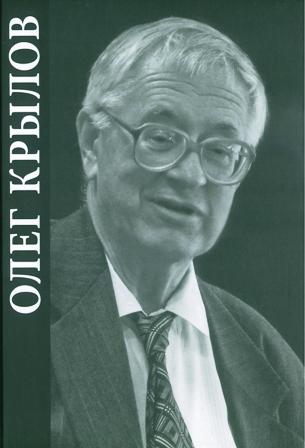 Сборник посвящен памяти Крылова Олега Валентиновича (1924-2008), крупного ученого-химика, известного практически во всех развитых странах
мира, где химическая наука и технология в значительной мере определяют промышленный потенциал. О.В. Крылов – доктор химических наук,
профессор, заведующий лабораторией Института химической физики им. Н.Н. Семенова РАН, член американских химических сообществ
(CACS), член редакционных коллегий иностранных и отечественных журналов по проблемам катализа и каталитической химии, наибольший вклад внес в
мировую науку в области общих проблем гетерогенного катализа. В последние годы жизни социальная ответственность перед обществом в условиях
нестационарного переходного периода от плановой экономики к свободному рынку заставили его обратиться к социальным проблемам. Малоизвестные
статьи О.В. Крылова составили основное содержание настоящего сборника. Об интересной личной жизни истинного интеллигента говорят люди,
близко знавшие его десятилетия.
Сборник посвящен памяти Крылова Олега Валентиновича (1924-2008), крупного ученого-химика, известного практически во всех развитых странах
мира, где химическая наука и технология в значительной мере определяют промышленный потенциал. О.В. Крылов – доктор химических наук,
профессор, заведующий лабораторией Института химической физики им. Н.Н. Семенова РАН, член американских химических сообществ
(CACS), член редакционных коллегий иностранных и отечественных журналов по проблемам катализа и каталитической химии, наибольший вклад внес в
мировую науку в области общих проблем гетерогенного катализа. В последние годы жизни социальная ответственность перед обществом в условиях
нестационарного переходного периода от плановой экономики к свободному рынку заставили его обратиться к социальным проблемам. Малоизвестные
статьи О.В. Крылова составили основное содержание настоящего сборника. Об интересной личной жизни истинного интеллигента говорят люди,
близко знавшие его десятилетия.
Кальнер В.Д. Экологическая парадигма глазами инженера
М: Калвис, 2009. – 400 с.
– ISBN 978-5-89530-014-5
 В книге на основании официальных документов и результатов оценки изменения состояния биосферы вследствие хозяйственной деятельности
человека показана необходимость участия каждого в сохранении и реабилитации окружающей природы и среды обитания. Автором сформулированы
представления об экологическом мировоззрении и экологической культуре – основах для разработчиков и создателей современной товарной продукции
и услуг, прослежены причины интенсивного нарастания экологического кризиса деградации природы и рассмотрены пути их преодоления. Книга
рассчитана на широкий круг читателей, обеспокоенных катастрофическим загрязнением и деградацией окружающей среды. Она будет полезна студентам
и преподавателям всех специальностей, инженерам, конструкторам и технологам, представителям власти и бизнеса – всем, кто думает о смысле и
качестве жизни своих современников и ближайших потомков.
В книге на основании официальных документов и результатов оценки изменения состояния биосферы вследствие хозяйственной деятельности
человека показана необходимость участия каждого в сохранении и реабилитации окружающей природы и среды обитания. Автором сформулированы
представления об экологическом мировоззрении и экологической культуре – основах для разработчиков и создателей современной товарной продукции
и услуг, прослежены причины интенсивного нарастания экологического кризиса деградации природы и рассмотрены пути их преодоления. Книга
рассчитана на широкий круг читателей, обеспокоенных катастрофическим загрязнением и деградацией окружающей среды. Она будет полезна студентам
и преподавателям всех специальностей, инженерам, конструкторам и технологам, представителям власти и бизнеса – всем, кто думает о смысле и
качестве жизни своих современников и ближайших потомков.
Из истории катализа: люди, события, школы
под общ. ред. Кальнера В.Д.
– М: Калвис, 2005. – 568 с. – ISBN 5-89530-003-0
 Книга представляет собой сборник авторских статей по истории катализа, в котором осмысливается зарождение и развитие различных направлений
фундаментальной и прикладной каталитической науки; становление каталитической индустрии в разных отраслях химии, нефтехимии, нефтепереработки;
создание и организация производства катализаторов для крупнотоннажных процессов; система подготовки кадров в области катализа в эпоху монархии,
республики Советов, Советского Союза и новой России.
Книга представляет собой сборник авторских статей по истории катализа, в котором осмысливается зарождение и развитие различных направлений
фундаментальной и прикладной каталитической науки; становление каталитической индустрии в разных отраслях химии, нефтехимии, нефтепереработки;
создание и организация производства катализаторов для крупнотоннажных процессов; система подготовки кадров в области катализа в эпоху монархии,
республики Советов, Советского Союза и новой России.
Флид М.Р., Трегер Ю.А. Винилхлорид: химия и технология
В 2-х кн. – М: Калвис, 2008. – 584 с. (Т. 1),
368 с. (Т. 2)- ISBN 978-5-89530-017-6 (общ.),
978-5-89530-019-0 (кн. 1), 978-5-89530-012-2 (кн. 2)
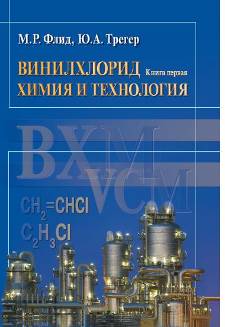
Винилхлорид – один из наиболее крупнотоннажных продуктов органического синтеза. Сведения о нем изложены в двух книгах. Обсуждаются
научные и прикладные аспекты способов получения винилхлорида, приведены основные кинетические и технологические закономерности, описаны
катализаторы, использующиеся в этих процессах, промышленное получение винилхлорида. Рассмотрена сырьевая база и варианты переработки отходов
производства. Приведены данные о влиянии винилхлорида на человека и окружающую среду. Изложены тенденции развития технологии производства
винилхлорида.
Промышленный катализ в лекциях
под общ. ред. Носкова А.С. – М: Калвис,
2005-2007. – ISBN 5-89530-004-9 (общ.)
В настоящее время в наличии выпуск № 8. Серия продолжается.
CD Диск “Промышленный катализ в лекциях”, вып. 1-8 в pdf
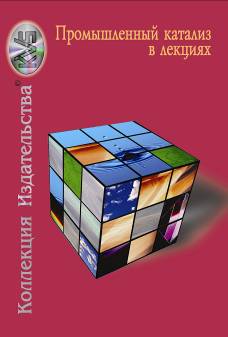
Сборники “Промышленный катализ в лекциях” – это серия материалов по основам промышленного катализа и его применению в отраслях химии. Материал лекций предназначен для инженерно-технических работников, занятых в производстве катализаторов и их носителей либо в производстве химических продуктов с использованием каталитических технологий, а также для преподавателей и студентов химических и химико-технологических факультетов, специализирующихся в области катализа.
|
|
119034, г. Москва, ул. Пречистенка, 37, стр. 2 Тел./факс (495) 913-80-94, 913-22-16 E-mail: info@kalvis.ru ctls@kalvis.ru www.kalvis.ru |


